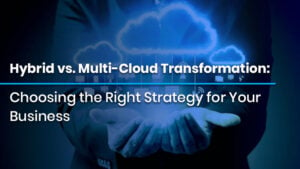
How to Strengthen Security Using CIS Controls and Posture Analysis
How to Strengthen Security Using CIS Controls and Posture Analysis Introduction In the fast-paced and ever-evolving world of cybersecurity, defending digital infrastructure goes far
Master Azure Cloud with IPSpecialist! Gain expert-level skills with our in-depth Azure Courses. Take the next step in your Cloud journey – Start Learning Today!

How to Strengthen Security Using CIS Controls and Posture Analysis Introduction In the fast-paced and ever-evolving world of cybersecurity, defending digital infrastructure goes far

How to Prepare for the AWS Data Engineer Exam Introduction With the world becoming increasingly data-driven, organizations are depending on cloud-based systems to store, process,

Hybrid vs. Multi-Cloud Transformation: Choosing the Right Strategy for Your Business Introduction In the digital-first economy of today, cloud transformation is no longer a
Table of Contents
NoOps, DevOps, and ITOps, are three distinct concepts that are sometimes used interchangeably. They all have the same purpose: to improve the efficiency of a company’s infrastructure. However, there are some significant variances between the three.
DevOps, ITOps, and NoOps are three principles that can assist businesses in becoming as agile and safe as feasible. Understanding these ideas is essential for organizationally constructing the delivery pipeline.
With the increasing demand for machine learning, ITOPs, DevOps, and NoOps are gaining traction as solutions to operational models. The application of top operational methods will boost total productivity.
Both ITOps and DevOps are specializations inside IT departments. NoOps is more closely related to an organizational structure meant to eliminate the need for IT. This article will cover the detailed knowledge of ITOps, DevOps, and NoOps and their differences.
Check out our Courses now if you want to start your career in Cloud Computing and DevOps.
ITOps (or TecOps) is an abbreviation for IT Operations. IT Operations is the most traditional of the three concepts we will cover, and it also serves as the foundation for these more current techniques.
Any IT work, regardless of the business domain, can fall under the ITOps umbrella, as practically every business domain relies on IT for day-to-day operations. ITOps can be used in almost any sector.
ITOps focus more on stability and long-term dependability, with minimal support for agile and fast processes. Agility and speed are not, in general, the major concerns of ITOps. As a result, ITOps will appear strict with rigid workflows. This strategy is also oriented toward managing physical infrastructure with release-based, extensively tested software products where reliability and stability are critical.
This rigidity is also a significant disadvantage of ITOps. However, it may be an ideal solution for monolithic and slow-moving software development, such as in the financial services industry. However, in the continually evolving world of software development, ITOps has become obsolete. ITOps is not appropriate for such contexts because recent software advancements fall into this group.
DevOps brings together Development (Dev) and Operations (Ops) to bring people, processes, and technology together in application strategy, development, delivery, and operations. DevOps allows for coordination and collaboration between formerly separate tasks such as development, IT operations, quality engineering, and security.
Teams use DevOps culture, methods, and technologies to boost trust in the applications they produce, adapt better to customer requests, and achieve business goals more quickly. DevOps assists teams in providing continuous value to customers by generating better, more reliable goods.
DevOps in the organization powers previously unconnected operations like infrastructure provisioning and application deployments through a single unified delivery pipeline.
In a more traditional development approach, for example, developers would need to notify the operations team separately if they needed to deploy or reconfigure infrastructure to accommodate application changes. This procedure could cause major delays and bottlenecks in the delivery process.
DevOps, on the other hand, streamlines this process by allowing distinct teams to understand one another’s requirements. It enables them to anticipate and handle these requirements. This procedure can sometimes be automated, eliminating the need for manual intervention to manage the infrastructure.
NoOps is a recent concept that tries to entirely automate an IT environment regarding software deployment, monitoring, and improvement.
This makes it self-sufficient enough that the underlying infrastructure does not require a dedicated crew on-site to manage the software. Finally, NoOps allows developers to focus only on producing software while the operations element of the life cycle is completely automated, relieving the operations team of these responsibilities.
NoOps seeks to automate several components of ITOps that now require human intervention. When things go wrong, NoOps, like ITOps, will generate many logs, metrics, and traces that necessitate root cause analysis.
| Details | ITOps | DevOps | NoOps |
| Work Process | It controls and maintains all of an organization’s physical and software IT infrastructure components | It increases collaboration between developers and the operations team to improve software deployment quality and speed | It automates everything |
| Infrastructure Build | It manages the company’s software infrastructure by performing everyday duties and providing high-level technological direction | Infrastructure is allocated by DevOps based on full capacity workload | NoOps evaluate the cost of cloud resources based on budget and consider the smallest to maximum predicted consumption |
| Configuration | It allows business partners, outside groups, and regulatory bodies to access network configuration auditing information | It is responsible for configuring middleware platforms, operating systems, and hardware | It is used to set up cloud images (or elastic application platforms) |
| Capacity Planning | ITOps is the notion of maintaining and delivering all of a company’s IT staff’s applications, technologies, services, and infrastructure | The developers and operations departments collaborate to identify where the application can operate | NoOps create cloud resources that start gently and build up as quickly as needed |
Undoubtedly, every IT company relies on technology services to keep its operations running effectively .However, before selecting one or more concepts for the firm, one must analyze the organization’s current IT structure.
Among the three, DevOps is the most extensively used technique for enhancing corporate workflow. ITOps and NoOps will undoubtedly be as important and popular as DevOps in the next years.
© 2025 All rights reserved | Privacy Policy | Terms and Conditions | Sitemap | Cookie Policy




